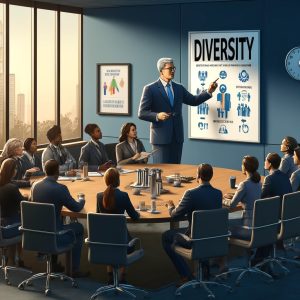Workplace diversity involves recognizing and valuing differences among employees in terms of age, gender, ethnicity, religion, disability, sexual orientation, education, and national origin. Achieving diversity isn’t just about fulfilling a quota; it’s about creating an inclusive environment that embraces different perspectives and experiences.
Commitment from leadership
Diversity initiatives must start at the top. Leadership commitment is crucial in driving diversity and inclusion within the organization. Leaders should actively endorse diversity goals and integrate them into the company’s vision and strategy.
How leaders can champion diversity and inclusion:
- Visible commitment: publicly and visibly champion diversity and inclusion initiatives. Speak openly about the importance of diversity and the value it brings to the organization.
- Strategic integration: integrate diversity and inclusion goals into the company’s overall strategy and business plan. This demonstrates a long-term commitment to creating a diverse and inclusive workplace.
- Accountability and measurement: establish clear metrics and hold yourself and others accountable for achieving diversity and inclusion goals. Regularly track progress and make adjustments as needed.
- Allocation of resources: allocate necessary resources to support diversity and inclusion initiatives. This may include funding for training programs, employee resource groups, or unconscious bias training.
- Walk the walk: leaders must embody the values of diversity and inclusion in their own behaviour. Treat everyone with respect, value diverse perspectives, and actively seek out and listen to different voices.
- Building a diverse leadership team: diversity at the top matters. Actively strive to build a diverse leadership team that reflects the demographics of your workforce and customer base.
- Sponsorship and mentorship: encourage leaders to sponsor and mentor employees from diverse backgrounds. This provides valuable support and guidance for career development and advancement.
By taking these steps, leaders can demonstrate their genuine commitment to diversity and inclusion. This commitment is essential for creating a workplace where everyone feels valued, respected, and empowered to contribute their best work. A strong leadership commitment to diversity and inclusion is not just the right thing to do, it’s also good for business. Diverse and inclusive workplaces are proven to be more innovative, creative, and successful in the long run.
Inclusive recruitment practices
Recruitment practices significantly impact workplace diversity. By implementing inclusive recruitment strategies, organizations can attract a wider pool of qualified candidates and build a more diverse and talented workforce. Here are some key strategies to consider:
- Targeting diverse talent pools: utilize diverse job boards and recruitment channels that cater to underrepresented groups. Partner with diversity-focused organizations and attend job fairs specifically targeting diverse candidates.
- Unbiased screening processes: implement unbiased screening processes that focus on skills and qualifications, rather than factors unrelated to the job. This may include utilizing skills-based assessments or standardized testing.
- Blinding resumes and applications: consider implementing blind recruitment practices, where identifying information such as name, gender, or age is removed from resumes and applications during the initial screening process. This helps to minimize unconscious bias and ensure candidates are assessed based on their qualifications.
- Diverse hiring panels: ensure diversity in hiring panels by including individuals from different backgrounds and demographics. This allows for a wider range of perspectives to be considered during the interview process.
- Inclusive job descriptions: write inclusive job descriptions that avoid biased language and highlight the company’s commitment to diversity and inclusion. Focus on the required skills and experience, and use gender-neutral language.
- Clear communication and accessibility: clearly communicate the application process and ensure it’s accessible to candidates with disabilities. Offer alternative formats for job descriptions and applications upon request.
- Interview training: provide interview training for hiring managers and recruiters on unconscious bias and inclusive interviewing practices. This equips them to conduct fair and objective interviews.
By implementing these inclusive recruitment practices, organizations can create a more diverse talent pool, attract top candidates from all backgrounds, and ultimately build a stronger and more successful workforce. A diverse workforce fosters creativity, innovation, and problem-solving, leading to a competitive advantage in the marketplace.
Offering training and education
Educational programs and training sessions on diversity, inclusion, and cultural competency are vital. They help employees understand the importance of diversity and how to work effectively in a diverse environment.
Effective diversity and inclusion training:
- Diversity and inclusion fundamentals: provide foundational training on diversity, inclusion, and unconscious bias. This helps employees understand the concepts, recognize their own biases, and learn strategies to mitigate their impact.
- Cultural competency training: offer cultural competency training that equips employees with the skills to interact effectively with colleagues from diverse backgrounds. This may include training on cultural norms, communication styles, and religious practices.
- Microaggressions and bystander intervention: educate employees about microaggressions, subtle forms of bias that can create a hostile work environment. Train employees on bystander intervention strategies to address microaggressions and promote a culture of respect.
- Inclusive communication skills: develop inclusive communication skills by teaching employees how to use gender-neutral language, avoid stereotypes, and actively listen to different perspectives.
- Ongoing learning and development: diversity and inclusion training shouldn’t be a one-time event. Offer ongoing learning and development opportunities, such as workshops, speaker series, or employee resource groups, to foster continuous learning and growth.
- Tailored training programs: consider tailoring training programs to address specific needs within your organization. This may involve training on specific cultural groups or diversity issues relevant to your workforce.
By investing in training and education, organizations can empower employees to embrace diversity, build stronger relationships with colleagues, and ultimately contribute to a more inclusive and productive work environment. Effective diversity and inclusion training goes beyond awareness; it equips employees with the skills and knowledge to create a workplace where everyone thrives.
Creating diversity policies and goals
Developing clear diversity policies and setting measurable goals is essential for tracking progress. Policies should address all aspects of employment, including hiring, training, promotions, and pay equity.
Encouraging employee resource groups
Leverage Employee Resource Groups (ERGs) as a resource to identify and address any barriers to equity and fairness within the organization. ERGs for different minority groups can provide support, enhance career development, and offer networking opportunities. These groups can also offer valuable insights to the company on diversity and inclusion matters.
Regular review and adaptation
Diversity initiatives should be regularly reviewed and adapted based on their effectiveness and the evolving needs of the organization. This involves tracking diversity metrics and gathering feedback from employees. Create safe and anonymous employee feedback mechanisms to identify and address any existing inequities or unfair practices within the organization. This could include anonymous surveys, focus groups, or suggestion boxes. Utilize data analysis to identify any disparities in opportunities, compensation, or promotions across different employee groups. Data-driven insights can help pinpoint areas where improvements are needed to promote existing equity and fairness.
Promoting equity and fairness
Diversity goes hand in hand with equity and fairness. Organizations should ensure that all employees have access to the same opportunities and are evaluated by the same criteria. Recognize and celebrate employees who champion diversity and inclusion initiatives within the company. This reinforces the importance of these values and motivates others to get involved.
Creating an inclusive work-environment
Achieving workplace diversity is a continuous process that requires a strategic and thoughtful approach. It’s about creating a work environment where diverse talents are valued and integrated into the organization’s fabric. By embracing diversity, organizations not only enhance their cultural richness but also improve their competitiveness and ability to innovate.





